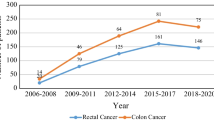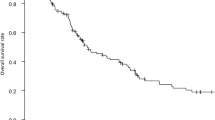Abstract
Background and aims
Colorectal cancer (CRC) is the third most common cause of cancer-related death in Taiwan. During the past 20 years, several advances have improved the treatment outcome and quality of life of CRC patients. The purpose of this study was to identify the changes in the clinicopathological features and outcome of CRC over this period.
Materials and methods
Based on the computerized database of the Taipei Veterans General Hospital, between January 1981 and December 2000, 5,474 CRC patients were identified and divided into 2 groups based on the date of treatment (1981–1990 and 1991–2000). The clinicopathological features, outcome, and prognostic factors were analyzed and compared.
Results/findings
The age at onset of cancer was 61 years in the 1980s group and 66 years in the 1990s group. The frequency of rectal tumors decreased from 50% in the 1980s group to 44% in the 1990s group. Tumor, nodes, metastasis (TNM) stage distribution, surgical mortality, and anastomosis leakage were similar in the two groups. However, the 5-year overall survival rate was better in the 1990s group (56%) than that in the 1980s group (50%, P = 0.001). For rectal cancer patients, the local recurrence rate was lower in the 1990s group (6%) than that in the 1980s group (10%, P < 0.01). In stage III CRC, the 5-year overall survival rate was significantly higher in the 1990s group (54%) than that in the 1980s group (48%, P = 0.011). TNM stage was the most important independent prognostic factor for overall and disease-free survivals, followed by differentiation grade, CEA level, and treatment period.
Interpretation/conclusion
Advances in surgical technique and more standard use of chemotherapy have improved CRC outcome.

Similar content being viewed by others
References
Weitz J, Koch M, Debus J et al (2005) Colorectal cancer. Lancet 365:153–165
Health and Vital Statistics (2000) Department of Health, ROC, Taipei
Compton CC, Fielding LP, Burgart LJ et al (2000) Prognostic factors in colorectal cancer. College of American Pathologists Consensus Statement 1999. Arch Pathol Lab Med 124:979–994
Gill S, Loprinzi CL, Sargent DJ et al (2004) Pooled analysis of fluorouracil-based adjuvant therapy for stage II and III colon cancer: who benefits and by how much? J Clin Oncol 22:1797–1806
Marsoni S, International Multicenter Pooled Analysis of Colon Cancer Trials Investigators (2001) Efficacy of adjuvant fluorouracil and leucovorin in stage B2 and C colon cancer. International Multicenter Pooled Analysis of Colon Cancer Trials Investigators. Semin Oncol 28:14–19
Dahlberg M, Pahlman L, Bergstrom R et al (1998) Improved survival in patients with rectal cancer: a population-based register study. Br J Surg 85:515–520
Enker WE, Thaler HT, Cranor ML et al (1995) Total mesorectal excision in the operative treatment of carcinoma of the rectum. J Am Coll Surg 181:335–346
Zhao GP, Zhou ZG, Lei WZ et al (2005) Pathological study of distal mesorectal cancer spread to determine a proper distal resection margin. World J Gastroenterol 11:319–322
Rullier E, Laurent C, Bretagnol F et al (2005) Sphincter-saving resection for all rectal carcinomas: the end of the 2-cm distal rule. Ann Surg 241:465–469
Schiessel R, Novi G, Holzer B et al (2005) Technique and long-term results of intersphincteric resection for low rectal cancer. Dis Colon Rectum 48:1858–1865 (discussion 1865–1867)
American Joint Committee on Cancer (1997) AJCC cancer staging manual, 5th edn. Springer, Berlin Heidelberg New York
Mostafa G, Matthews BD, Norton HJ et al (2004) Influence of demographics on colorectal cancer. Am Surg 70:259–264
Mensink PB, Kolkman JJ, Van Baarlen J et al (2002) Change in anatomic distribution and incidence of colorectal carcinoma over a period of 15 years: clinical considerations. Dis Colon Rectum 45:1393–1396
Takada H, Ohsawa T, Iwamoto S et al (2002) Changing site distribution of colorectal cancer in Japan. Dis Colon Rectum 45:1249–1254
Newcomb PA, Norfleet RG, Storer BE et al (1992) Screening sigmoidoscopy and colorectal cancer mortality. J Natl Cancer Inst 84:1572–1575
Selby JV, Friedman GD, Quesenberry CP Jr et al (1992) A case-control study of screening sigmoidoscopy and mortality from colorectal cancer. N Engl J Med 326:653–657
Ransohoff DF, Lang CA (1993) Sigmoidoscopic screening in the 1990s. JAMA 269:1278–1281
Williams NS, Dixon MF, Johnston D (1983) Reappraisal of the 5 centimetre rule of distal excision for carcinoma of the rectum: a study of distal intramural spread and of patients’ survival. Br J Surg 70:150–154
Kameda K, Furusawa M, Mori M et al (1990) Proposed distal margin for resection of rectal cancer. Jpn J Cancer Res 81:100–104
Simstein NL, Kovalcik PJ, Cross GH (1978) Colorectal carcinoma in patients less than 40 years old. Dis Colon Rectum 21:169–171
Qing SH, Rao KY, Jiang HY et al (2003) Racial differences in the anatomical distribution of colorectal cancer: a study of differences between American and Chinese patients. World J Gastroenterol 9:721–725
Marble K, Banerjee S, Greenwald L (1992) Colorectal carcinoma in young patients. J Surg Oncol 51:179–182
Faivre-Finn C, Bouvier-Benhamiche AM, Phelip JM et al (2002) Colon cancer in France: evidence for improvement in management and survival. Gut 51:60–64
Finn-Faivre C, Maurel J, Benhamiche AM et al (1999) Evidence of improving survival of patients with rectal cancer in France: a population based study. Gut 44:377–381
Porter GA, Soskolne CL, Yakimets WW et al (1998) Surgeon-related factors and outcome in rectal cancer. Ann Surg 227:157–167
Smith JA, King PM, Lane RH et al (2003) Evidence of the effect of ‘specialization’ on the management, surgical outcome and survival from colorectal cancer in Wessex. Br J Surg 90:583–592
Scott KW, Grace RH (1989) Detection of lymph node metastases in colorectal carcinoma before and after fat clearance. Br J Surg 76:1165–1167
Maurel J, Launoy G, Grosclaude P et al (1998) Lymph node harvest reporting in patients with carcinoma of the large bowel: a French population-based study. Cancer 82:1482–1486
Shen M-Y, Lin J-K, Lin T-C et al (2003) Prognostic significance of lymph node metastasis in resected colorectal cancer. J Soc Colon Rectal Surgeon (Taiwan) 14:7–14
Buroker TR, O’Connell MJ, Wieand HS et al (1994) Randomized comparison of two schedules of fluorouracil and leucovorin in the treatment of advanced colorectal cancer. J Clin Oncol 12:14–20
Francini G, Petrioli R, Lorenzini L et al (1994) Folinic acid and 5-fluorouracil as adjuvant chemotherapy in colon cancer. Gastroenterology 106:899–906
Moertel CG (1994) Chemotherapy for colorectal cancer. N Engl J Med 330:1136–1142
Moertel CG, Fleming TR, Macdonald JS et al (1990) Levamisole and fluorouracil for adjuvant therapy of resected colon carcinoma. N Engl J Med 322:352–358
Arkenau HT, Bermann A, Rettig K et al (2003) 5-Fluorouracil plus leucovorin is an effective adjuvant chemotherapy in curatively resected stage III colon cancer: long-term follow-up results of the adjCCA-01 trial. Ann Oncol 14:395–399
Sargent DJ, Goldberg RM, Jacobson SD et al (2001) A pooled analysis of adjuvant chemotherapy for resected colon cancer in elderly patients. N Engl J Med 345:1091–1097
Potosky AL, Harlan LC, Kaplan RS et al (2002) Age, sex, and racial differences in the use of standard adjuvant therapy for colorectal cancer. J Clin Oncol 20:1192–1202
Ayanian JZ, Zaslavsky AM, Fuchs CS et al (2003) Use of adjuvant chemotherapy and radiation therapy for colorectal cancer in a population-based cohort. J Clin Oncol 21:1293–1300
Fata F, Mirza A, Craig G et al (2002) Efficacy and toxicity of adjuvant chemotherapy in elderly patients with colon carcinoma: a 10-year experience of the Geisinger Medical Center. Cancer 94:1931–1938
Iwashyna TJ, Lamont EB (2002) Effectiveness of adjuvant fluorouracil in clinical practice: a population-based cohort study of elderly patients with stage III colon cancer. J Clin Oncol 20:3992–3998
Jessup JM, Stewart A, Greene FL et al (2005) Adjuvant chemotherapy for stage III colon cancer: implications of race/ethnicity, age, and differentiation. JAMA 294:2703–2711
Fernando NH, Hurwitz HI (2003) Inhibition of vascular endothelial growth factor in the treatment of colorectal cancer. Semin Oncol 30:39–50
O’Dwyer PJ, Benson AB 3rd (2002) Epidermal growth factor receptor-targeted therapy in colorectal cancer. Semin Oncol 29:10–17
Kitisin K, Mishra L (2006) Molecular biology of colorectal cancer: new targets. Semin Oncol 33(Suppl 11):14–23
Wilson RH (2006) Novel therapeutic developments other than EGFR and VEGF inhibition in colorectal cancer. Oncologist 11:1018–1024
Author information
Authors and Affiliations
Corresponding author
Rights and permissions
About this article
Cite this article
Ju, JH., Chang, SC., Wang, HS. et al. Changes in disease pattern and treatment outcome of colorectal cancer: a review of 5,474 cases in 20 years. Int J Colorectal Dis 22, 855–862 (2007). https://doi.org/10.1007/s00384-007-0293-z
Accepted:
Published:
Issue Date:
DOI: https://doi.org/10.1007/s00384-007-0293-z




